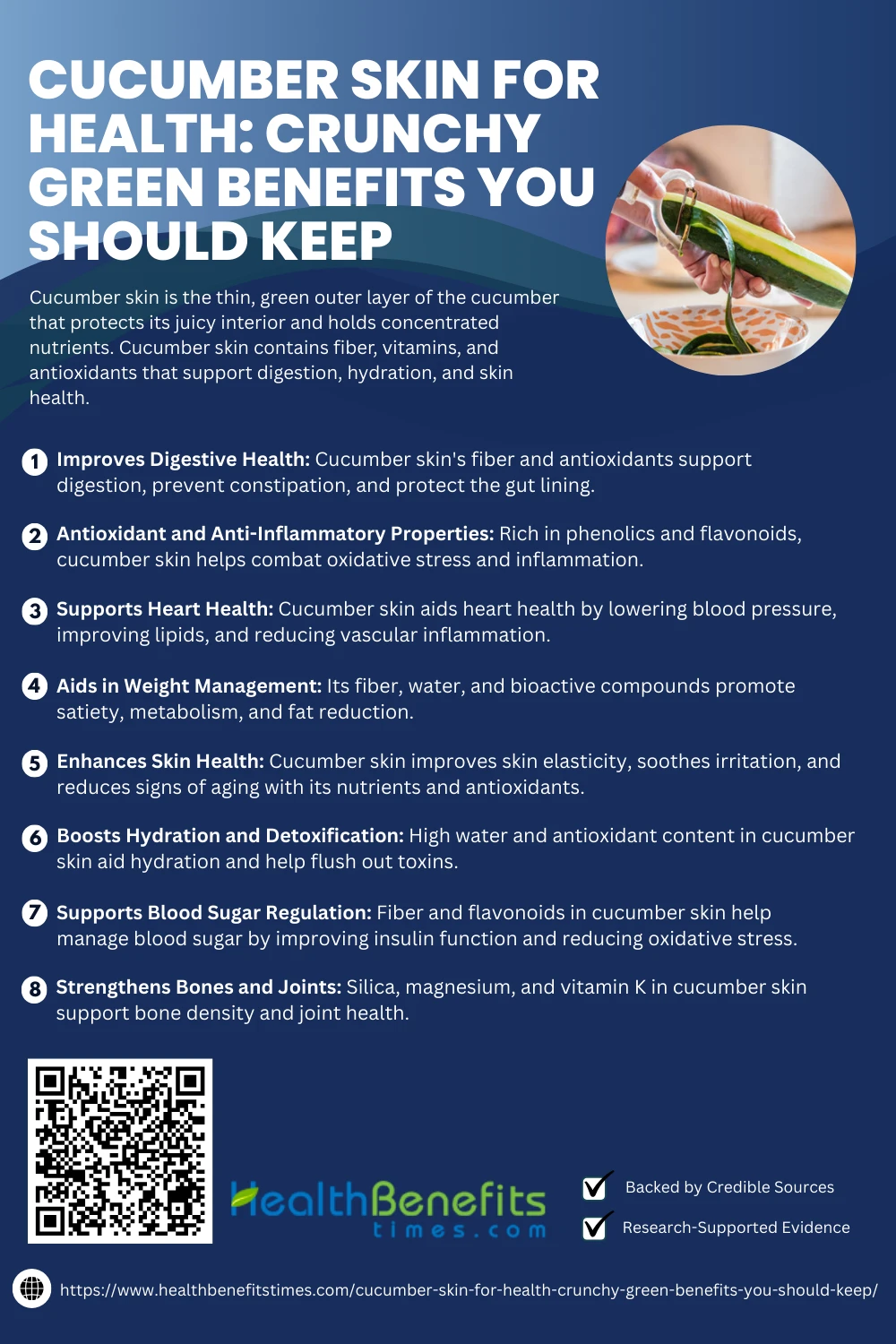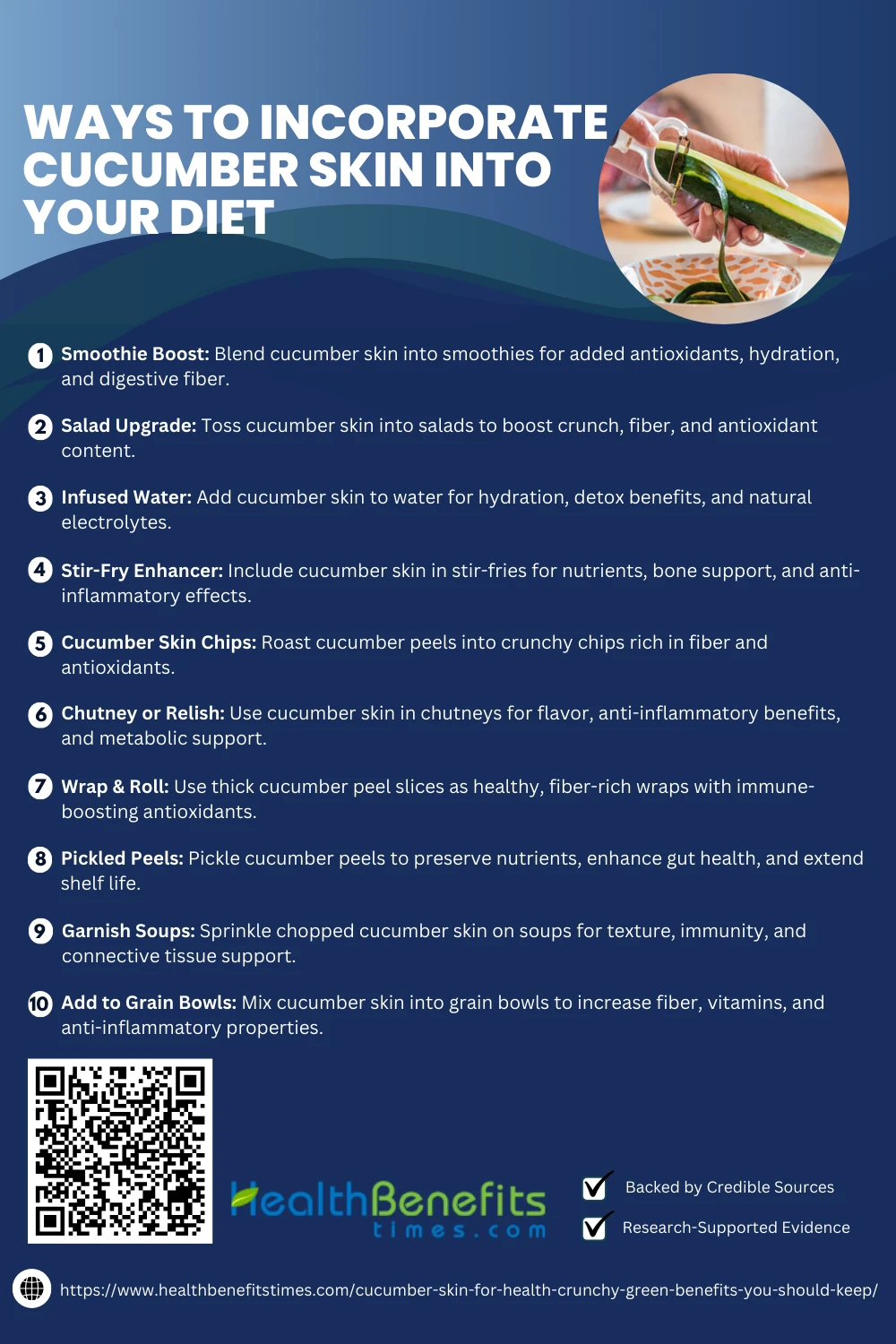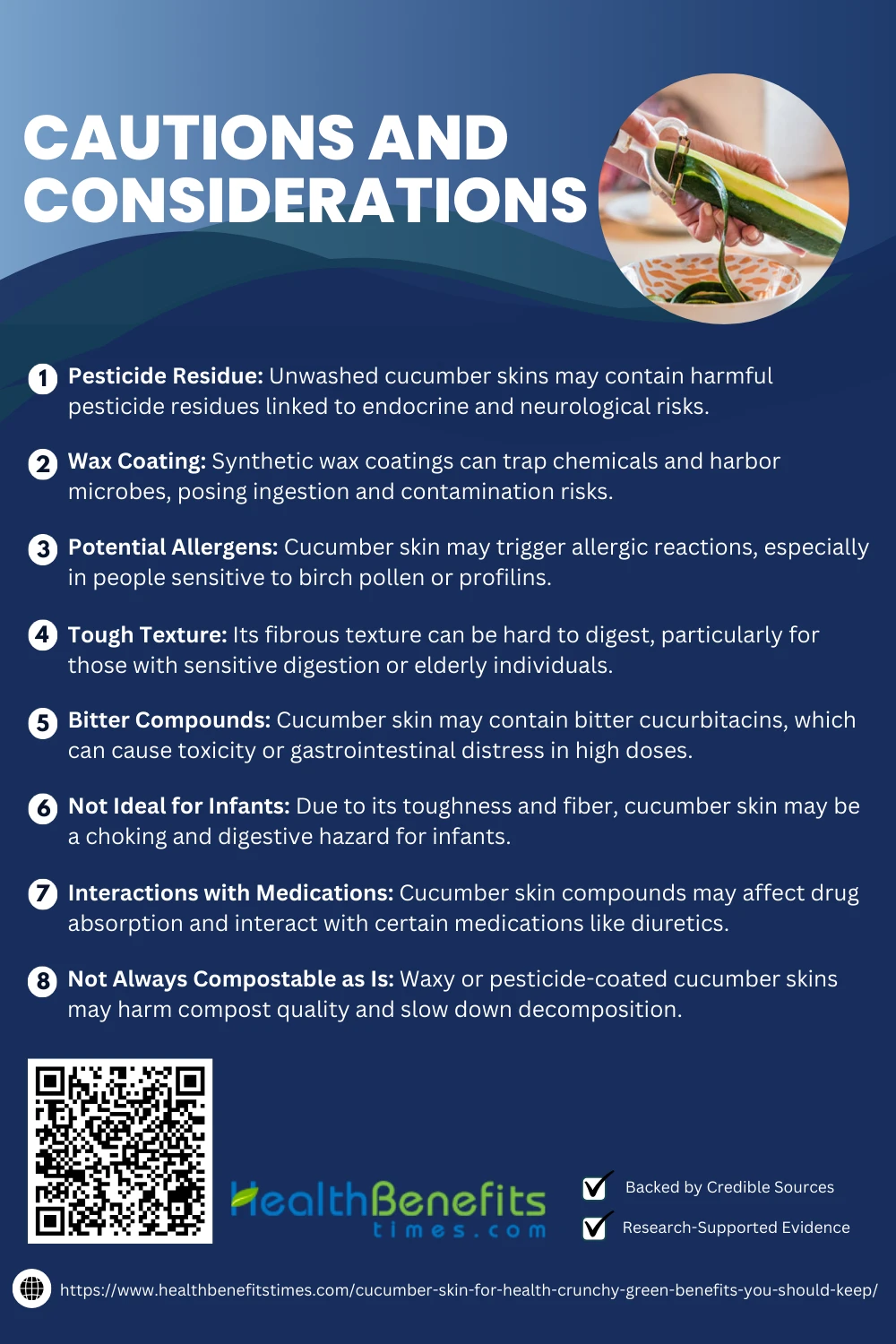- Cucumber skin is the thin, green outer layer of the cucumber that protects its juicy interior and holds concentrated nutrients.
- Cucumber skin contains fiber, vitamins, and antioxidants that support digestion, hydration, and skin health.
- Easy to add to your diet, cucumber skin should be washed well to remove pesticide residue before consumption.
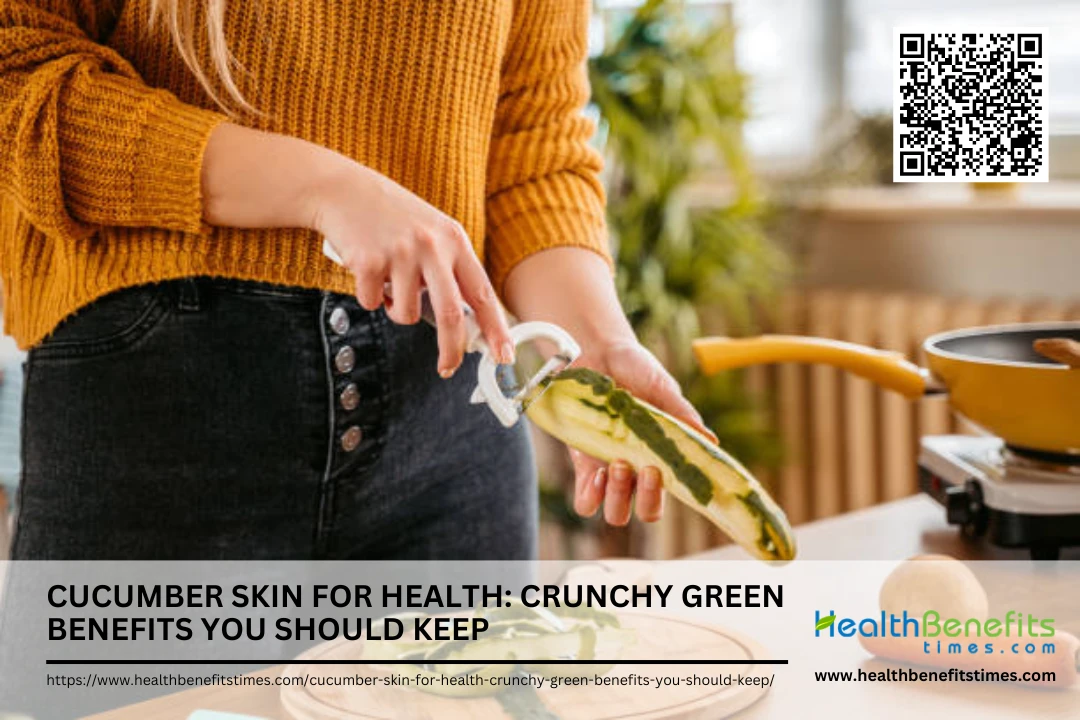 Cucumber skin is the thin, dark green outer layer of the cucumber fruit, rich in dietary fiber, vitamins, and antioxidants. Many people peel cucumbers without realizing that the vibrant green skin contains some of the most valuable nutrients. The skin is particularly high in antioxidants like flavonoids and tannins, which help fight inflammation and cellular damage. Additionally, cucumber skin has been shown to offer digestive support due to its insoluble fiber, which promotes healthy gut function. Emerging research suggests that incorporating unpeeled cucumbers into your diet could aid in weight management, reduce oxidative stress, and even support cardiovascular health.
Cucumber skin is the thin, dark green outer layer of the cucumber fruit, rich in dietary fiber, vitamins, and antioxidants. Many people peel cucumbers without realizing that the vibrant green skin contains some of the most valuable nutrients. The skin is particularly high in antioxidants like flavonoids and tannins, which help fight inflammation and cellular damage. Additionally, cucumber skin has been shown to offer digestive support due to its insoluble fiber, which promotes healthy gut function. Emerging research suggests that incorporating unpeeled cucumbers into your diet could aid in weight management, reduce oxidative stress, and even support cardiovascular health.
Nutritional Profile of Cucumber Skin
Cucumber skin is packed with essential nutrients often overlooked. It contains vitamins, minerals, antioxidants, and fiber that contribute to overall wellness, making it a crunchy, green powerhouse you shouldn’t discard.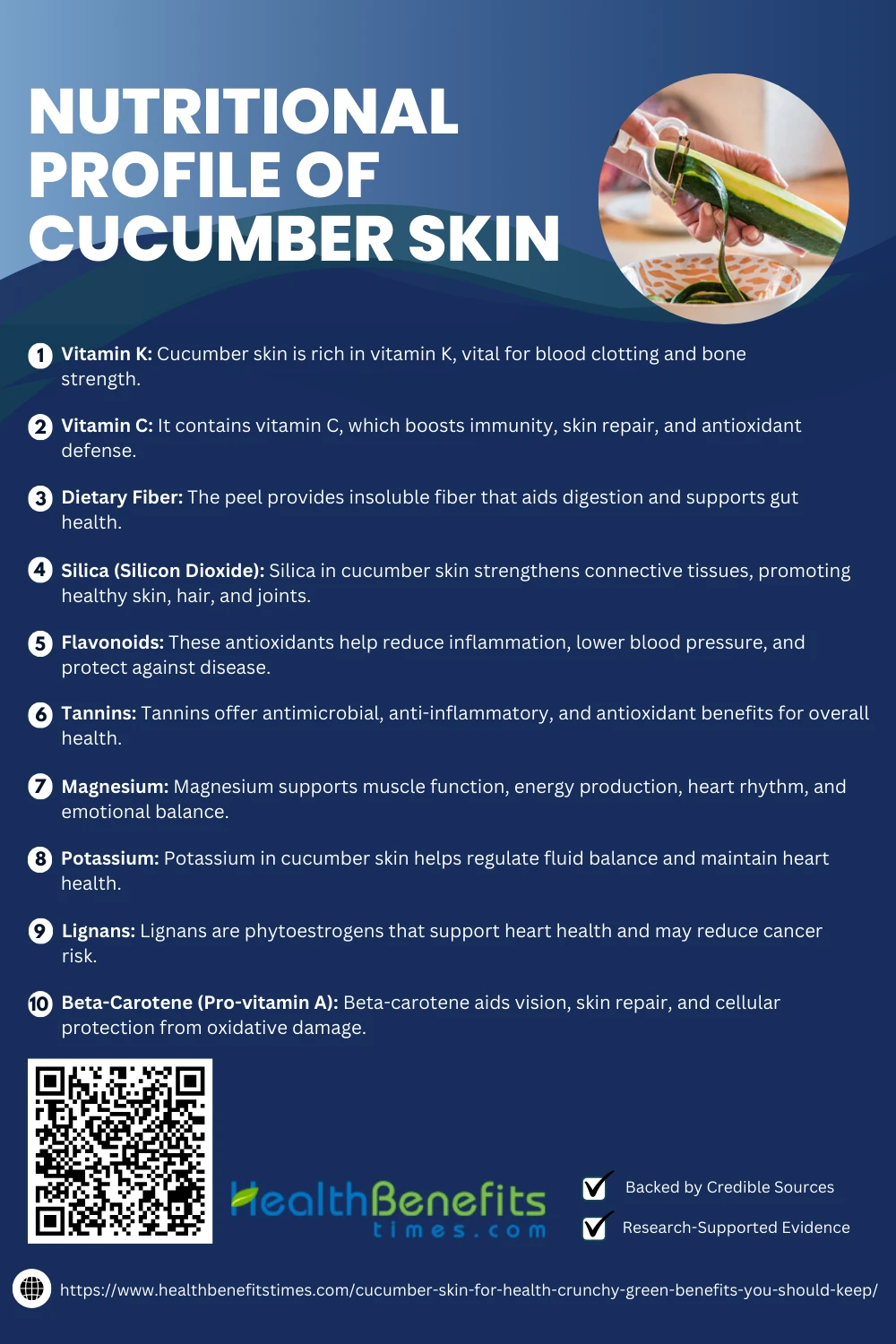 1. Vitamin K
1. Vitamin K
Cucumber skin is an excellent source of vitamin K, essential for blood clotting and bone health. Studies have shown it contributes to reducing fracture risks and maintaining calcium balance in the body. (1) (2)
2. Vitamin C
Packed in cucumber peel, vitamin C is a powerful antioxidant that boosts immunity and skin repair. It helps protect cells from oxidative stress and supports collagen production vital for youthful skin. (3) (4)
3. Dietary Fiber
Cucumber skin contains insoluble fiber, which promotes digestive health by enhancing stool bulk and regularity. (5) It also aids in maintaining gut microbiota balance and reducing constipation risk. (6)
4. Silica (Silicon Dioxide)
Silica in cucumber skin supports connective tissue and enhances hair and skin strength. It plays a role in collagen formation and may improve bone mineral density and joint flexibility. (7) (8)
5. Flavonoids
These potent antioxidants in cucumber peel—like quercetin—have anti-inflammatory, anti-viral, and anti-cancer effects. (9) Flavonoids also help lower blood pressure and improve heart health. (10)
6. Tannins
Tannins found in cucumber skin can suppress oxidative damage and possess antimicrobial properties. (11) They may also inhibit enzyme activities linked to inflammation and chronic disease. (12)
7. Magnesium
This mineral in cucumber peel supports over 300 enzymatic processes, including muscle function and energy production. (13) It also plays a key role in regulating mood and heart rhythm. (14)
8. Potassium
Cucumber skin provides potassium, which balances fluids and supports heart and muscle contractions. (15) High potassium intake is linked to lower blood pressure and reduced stroke risk. (16)
9. Lignans
Lignans in cucumber peel are phytoestrogens that may help reduce cancer risk, particularly breast and prostate. (17) They also support cardiovascular health by modulating lipid levels. (18)
10. Beta-Carotene (Pro-vitamin A)
Cucumber peel contains beta-carotene, a precursor to vitamin A that supports vision and skin repair. (19) It’s a potent antioxidant that defends cells against oxidative stress. (20)
Health Benefits of Eating Cucumber Skin
Eating cucumber skin offers a range of health benefits, from improved digestion and hydration to enhanced skin health and weight management. This nutrient-rich layer supports your body in many surprising ways.
Cucumber skin is rich in insoluble fiber, which plays a pivotal role in promoting healthy digestion by adding bulk to stool and preventing constipation. Its polyphenolic content supports gut microbial balance, as highlighted in a review on dietary fiber’s impact on gut health. (5) Additionally, antioxidants in cucumber peels combat gut inflammation, aligning with findings from antioxidant-rich vegetable studies. (21) Its hydrating effect, due to high water content, facilitates smoother digestion (source). (22) Flavonoids in cucumber peel may also exhibit anti-ulcer properties, supporting gut lining protection. (23) Overall, cucumber’s functional components present a promising natural aid for digestive wellness. (24)
2. Antioxidant and Anti-Inflammatory Properties
Cucumber skin exhibits notable antioxidant and anti-inflammatory properties, primarily due to its rich content of phenolic compounds and flavonoids. Studies reveal that cucumber peel extracts inhibit oxidative stress through free radical scavenging activity. Another investigation demonstrated its anti-inflammatory effect in reducing edema in rat models. (25) The presence of tannins and saponins enhances these effects. Additionally, its bioactives support skin health and prevent microbial infections. (26)
3. Supports Heart Health
Cucumber skin is rich in potassium, magnesium, and antioxidants, which are essential in maintaining cardiovascular health. Studies highlight its polyphenolic compounds help reduce blood pressure and oxidative stress. (26) The dietary fiber content improves lipid profiles. Additionally, cucumber peel extract reduces LDL oxidation, supports endothelial function, and protects against vascular inflammation. (25)
4. Aids in Weight Management
Cucumber skin contributes to weight management due to its high fiber and water content, promoting satiety and digestive health. Research confirms that its insoluble fiber reduces calorie absorption. Bioactive compounds enhance metabolism and fat oxidation. The low glycemic index helps control appetite, and phytosterols modulate fat accumulation. (26) It also improves gut microbiota, aiding digestion. (25)
5. Enhances Skin Health
Cucumber skin is abundant in silica, vitamin C, and caffeic acid, which play vital roles in promoting skin elasticity and reducing inflammation. (26) Its antioxidant profile combats premature aging by reducing oxidative stress. It soothes skin irritations and sunburns. (25) Additionally, cucumber peel extract stimulates collagen production and supports hydration in topical formulations.
6. Boosts Hydration and Detoxification
Cucumber skin contributes significantly to hydration and detoxification due to its high water content and presence of ascorbic and caffeic acids. (26) Its diuretic properties help eliminate toxins via urine. (25) Studies show that polyphenols in cucumber peel aid liver detox pathways. Potassium-rich cucumber skin regulates body fluid balance, while antioxidants reduce internal oxidative load.
7. Supports Blood Sugar Regulation
Cucumber skin plays a role in managing blood glucose levels due to its fiber and phenolic content, which improve insulin sensitivity. Research has shown its aqueous extract reduces fasting blood sugar in diabetic models. (25) The flavonoids present modulate glucose metabolism. Cucumber also aids pancreatic function and prevents oxidative stress-induced insulin resistance. (26)
8. Strengthens Bones and Joints
Cucumber skin contributes to bone health through its high silica content, essential for collagen synthesis and joint integrity. (26) Magnesium and vitamin K in the peel enhance calcium absorption and bone density. Flavonoids reduce inflammation in joints, aiding conditions like arthritis. Antioxidants in cucumber skin protect joint cartilage, and studies suggest it supports chondrocyte function. (25)
Ways to Incorporate Cucumber Skin into Your Diet
Cucumber skin is packed with nutrients and adds crunch, color, and fiber to meals. Discover easy, creative ways to enjoy its benefits by incorporating it into your everyday diet.
Adding cucumber skin to smoothies enhances antioxidant intake due to its rich polyphenol content. The peel provides hydrating electrolytes and silica for skin health. (26) Its fiber also improves digestive efficiency during metabolism.
2. Salad Upgrade
Cucumber skin adds crunch and nutritional depth to salads, delivering essential flavonoids and tannins. Its antioxidant properties combat oxidative stress when consumed raw. Additionally, it supports gut health through dietary fiber. (26)
3. Infused Water
Cucumber skin elevates infused water by delivering hydration-supporting electrolytes and antioxidants. (26) Its flavonoids help detoxify and reduce oxidative stress. The peel’s natural diuretic effect enhances toxin elimination and supports kidney health. (25)
4. Stir-Fry Enhancer
Cucumber skin brings both texture and nutrients to stir-fries, supplying silica and vitamin K for bone strength. (26) Its antioxidants remain stable under light cooking, while phenolic compounds provide anti-inflammatory benefits.
5. Cucumber Skin Chips
Roasting cucumber skin into chips retains its antioxidant potential while adding crunch. The peel’s fiber content promotes satiety and digestive health. Phytochemicals like tannins and flavonoids remain active even after light heating.
6. Chutney or Relish
Cucumber skin is excellent in chutneys due to its bioactive compounds that offer anti-inflammatory benefits. Blending it preserves fiber and minerals essential for metabolism. Its antioxidant profile also enhances flavor and shelf life.
7. Wrap & Roll
Thick cucumber skin slices serve as nutritious wraps, rich in fiber and antioxidants that support digestion and immunity. Their firmness retains texture, while phenolics like flavonoids offer anti-inflammatory benefits and combat oxidative damage.
8. Pickled Peels
Pickling cucumber peels enhances their shelf life and preserves bioactives such as polyphenols and tannins. Fermentation boosts probiotic potential and gut health, while the antioxidant content remains stable through vinegar-based preservation.
9. Garnish Soups
Finely chopped cucumber skin adds texture and nutrition to soups, providing antioxidants that resist light heat exposure. Its polyphenols support immunity, while the silica content benefits skin and connective tissue health. (26)
10. Add to Grain Bowls
Adding cucumber skin to grain bowls boosts their fiber and hydration value, aiding digestion and satiety. The peel’s flavonoids reduce inflammation, and its vitamin-rich profile enhances nutrient density without altering taste. (26)
Cautions and Considerations
While cucumber skin offers health benefits, it’s important to consider potential risks like pesticide residue or digestive sensitivity. Understanding proper preparation and moderation ensures safe and beneficial consumption of cucumber skin.
Cucumber skins often contain pesticide residues, posing potential health risks if consumed unwashed or unpeeled. Studies have shown that organochlorine and organophosphate residues can accumulate on cucumber surfaces, potentially disrupting endocrine functions. (27) A global residue analysis found that many cucumbers exceeded maximum residue limits (MRLs), increasing chronic toxicity risks. (28) Additionally, frequent pesticide exposure through produce like cucumbers has been linked to long-term neurological effects, especially in vulnerable populations. (29)
2. Wax Coating
Cucumber skins are often coated with synthetic wax to prolong shelf life, yet this wax may trap pesticide residues or introduce petroleum-based compounds. A review on waxes highlights potential ingestion risks, while FDA documentation cautions on non-food-grade waxes. (30) Moreover, wax coatings may harbor microbial contaminants, increasing infection risk if not properly regulated. (31)
3. Potential Allergens
Though rare, cucumber skin can trigger allergic reactions, especially due to cross-reactivity with birch pollen proteins. (32) Individuals sensitive to profilins may experience oral allergy syndrome. (33) Additional studies indicate skin irritants can arise from handling raw cucumber peels, posing occupational risks in agriculture and food prep sectors. (34)
4. Tough Texture
Cucumber skin’s tough texture can hinder digestibility, particularly for individuals with gastrointestinal sensitivity. Research on dietary fiber resistance notes issues with cellulose-rich peels. (5) Additionally, the cuticle structure affects nutrient bioavailability, while chewing difficulty in elders poses nutritional intake challenges. (35) (36)
5. Bitter Compounds
Cucumber skins may contain cucurbitacins, naturally bitter compounds known for their toxicity in high doses. Studies link these compounds to gastrointestinal distress. (37) A toxicity evaluation confirms their potential hazard, especially in wild varieties, while genetic variability affects bitterness concentration in skin tissues. (38) (39)
6. Not Ideal for Infants
Cucumber skin’s high fiber and tough texture may pose choking hazards and digestive issues in infants. (40) Studies suggest that insoluble fibers are hard for immature guts to process. (41) Moreover, potential pesticide residues increase safety concerns when served unpeeled to babies. (27)
7. Interactions with Medications
Though uncommon, cucumber skin compounds may affect drug bioavailability by altering gut pH or enzyme activity. (42) Certain phytochemicals have shown mild cytochrome P450 inhibition, potentially affecting drug metabolism. (43) Also, high potassium content could interfere with diuretics or ACE inhibitors in sensitive individuals. (44)
8. Not Always Compostable as Is
Cucumber skins coated with synthetic wax or pesticide residues are not readily compostable, potentially harming soil health. (45) Studies show that persistent agrochemicals in produce waste can disrupt microbial ecosystems. (46) Moreover, non-biodegradable coatings slow decomposition, undermining compost efficiency and sustainability goals in waste management. (47)
Common Misconceptions and Concerns
1. Misconception: Cucumber Skin is Always Healthy
While cucumber skin is rich in dietary fiber and antioxidants like beta-carotene and flavonoids, it can also carry a hidden load of chemical residues. Conventionally farmed cucumbers often retain pesticide residues on their skins even after washing, potentially undermining the health benefits. (27) Thus, assuming all cucumber peels are healthy without considering their source may be misleading.
2. Concern: Wax Coatings are Harmless
Supermarket cucumbers are frequently coated with synthetic wax to preserve moisture and visual appeal. However, this wax can trap pesticide residues and sometimes include petroleum-derived compounds not meant for human ingestion. Research highlights concerns about non-biodegradable coatings, which may also impact digestion and composting. (31)
3. Misconception: All Bitterness is Natural and Safe
Cucumber bitterness usually comes from cucurbitacins, a group of naturally occurring compounds. In low doses, they are harmless, but some wild or stressed cucumbers may accumulate higher levels. These compounds have been linked to toxicity and gastrointestinal distress, especially if consumed in large quantities or raw. (37)
4. Concern: Peels are Tough but Digestible
Although the peel is edible, it contains high amounts of insoluble fiber and cellulose, which can challenge digestion. A study on fiber digestion shows that some individuals, particularly those with gastrointestinal sensitivity or IBS, may experience bloating or discomfort after eating cucumber skins. (5)
5. Misconception: All Cucumber Skins are Compostable
It’s often believed that all vegetable peels, including cucumber skins, are ideal for composting. However, skins coated with wax or containing pesticide residues may not break down efficiently and could introduce harmful residues to soil, impacting microbial biodiversity and compost quality. (46)
6. Concern: Safe for All Age Groups
Though cucumbers are often offered as a first food for babies, their skins may not be suitable for infants. The tough texture poses a choking hazard, and immature digestive systems may struggle with the fibrous content or trace contaminants on unpeeled cucumbers. (41)
7. Misconception: Peeling Removes All Risk
Peeling cucumbers can reduce exposure to surface-level pesticides, wax, and bitterness, but it does not eliminate internal risks. Cucurbitacins and systemically absorbed pesticides can remain in the inner tissues. Therefore, while peeling is helpful, it is not a foolproof method against all contaminants or compounds.
Conclusion
Cucumber skin, often overlooked and discarded, is a powerhouse of nutrition that offers a range of health benefits. From enhancing hydration and aiding digestion to delivering antioxidants and supporting skin health, its crunchy green exterior packs more than just texture. Incorporating cucumber skin into your meals not only reduces food waste but also boosts your nutrient intake naturally. However, always wash thoroughly to remove any pesticide residues. With thoughtful preparation, this vibrant peel can become a delicious and healthful addition to your diet. So, don’t peel away the goodness—embrace the benefits of cucumber skin for a healthier lifestyle.



